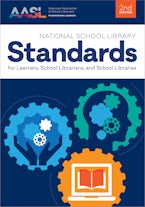List of Illustrations
List of Tables
Preface
Acknowledgments
Introduction
PART I: STANDARDS AND SCHOOL LIBRARY PRACTICE
Chapter 1: Grounding Principles of the Profession
- Common Beliefs
- Roles of the School Librarian
- Synergy in Action
Chapter 2: Introduction to the AASL Standards
- Defining Competency-Based Education
- Exploring the Structure of the National School Library Standards
- Understanding Competency and Growth
- AASL Standards Within the Educational Landscape
PART II: SHARED FOUNDATIONS AND INTEGRATED FRAMEWORKS
Chapter 3: Inquire
- Common Beliefs
- Think
- Create
- Share
- Grow
Chapter 4: Include
- Common Beliefs
- Think
- Create
- Share
- Grow
Chapter 5: Collaborate
- Common Beliefs
- Think
- Create
- Share
- Grow
Chapter 6: Curate
- Common Beliefs
- Think
- Create
- Share
- Grow
Chapter 7: Explore
- Common Beliefs
- Think
- Create
- Share
- Grow
Chapter 8: Engage
- Common Beliefs
- Think
- Create
- Share
- Grow
PART III: ASSESSMENT AND EVALUATION
Chapter 9: Measuring Learner Growth
- Assessment in a Competency-Based Environment
- Integrating Instruction for Holistic Assessment
- Creating an Assessment
- Types of Assessment
- Rating Schemes and Scales for Assessments
- Ensuring Success Through Assessment
Chapter 10: Measuring School Librarian Growth
- Dimensions of Professional Activity
- Developing a Growth Plan
- Measurements Through Key Commitments
- Fostering Growth Through Self-Evaluation
Chapter 11: Evaluating School Libraries
- Engaging Administrators on Effective School Libraries
- Analysis Tools Supporting Evaluation and Strategic Planning
- Demonstrating Evaluation and Analysis Tools in Practice
- Gaining Confidence Through Evaluation
PART IV: SCENARIOS FOR COMMON CHALLENGES
Chapter 12: Scenarios for Working with Learners
- English Learners: Locating Accessible Quality Information
- Formative Assessment: Modifying Instruction for Struggling Learners
- Inquiry Instruction: Serving Multiple Buildings Effectively
- Makerspace Start-Up: Establishing a Makerspace Without Funding
- Nonresponsive Schedule: Ensuring Access for Learners at Point of Need
- Reflective Collections: Representing Underserved Populations
- Technology Integration: Modeling Technology-Enhanced Teaching and Learning
- Various Perspectives: Promoting Inclusivity in the School Library
Chapter 13: Scenarios for Working with Collaborators
- Challenged Collection: Explaining the Collection Development Process
- Copyright Compliance: Adhering to Fair Use Guidelines
- Excluded Librarian: Promoting the Instructional Partner Role
- Inclusive Projects: Ensuring That Learning Tasks Offer Various Perspectives
- Misunderstood Professionals: Defining School Library Staff Roles
- Reluctant Collaborators: Advocating for Co-teaching with Content-Area Educators
Chapter 14: Scenarios for Working with Administrators
- Budget Support: Advocating for Adequate Funding
- Makerspace Access: Advocating for Makerspace Access for All Learners
- Overlooked Professional: Advocating for Leadership Positions
- Professional Growth: Advocating for Inquiry Training
- Resource Purchases: Demonstrating Database Usage
- Strategic Plan: Advocating for School Library Growth
Chapter 15: Scenarios for Working with Community Members
- Book Challenges: Responding to Parent Complaints About Library Books
- Committee Representation: Embedding the Library in Campus Improvement
- Parent Engagement: Gathering Input for New Resources
- PTA Partnerships: Building Common Ground for Collaboration
- State Standards: Anticipating Legislative Questions About Standards Adoption
- Technology Use: Calming Parent Screen-Time Concerns
- Volunteer Management: Protecting Learners’ Privacy and Parent Volunteers
APPENDIXES
- Appendix A: AASL Standards Framework for Learners
- Appendix B: AASL Standards Framework for School Librarians
- Appendix C: AASL Standards Framework for School Libraries
- Appendix D: AASL Position Statements and Resources
- Appendix E: Library Bill of Rights
Works Cited
Index

